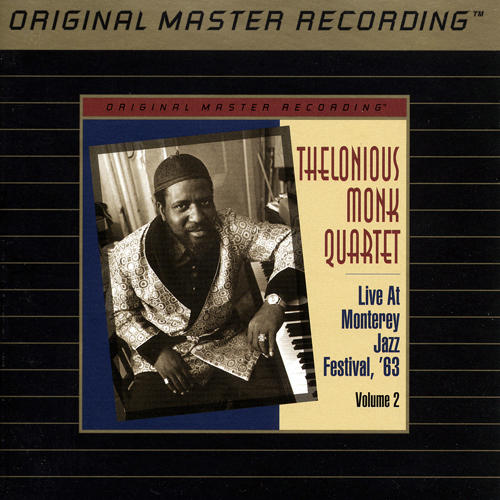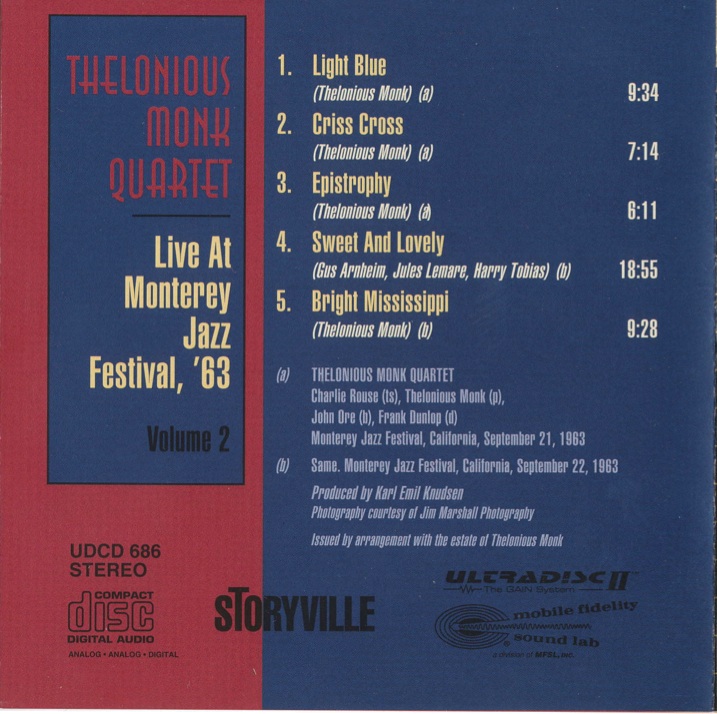

BOOKLET
———————————————————————
Thelonious Monk Quartet – Live at Monterey Jazz Festival ’63
———————————————————————
Artist……………: Thelonious Monk Quartet
Album…………….: Live at Monterey Jazz Festival ’63
Genre…………….: Jazz
Source……………: NMR
Year……………..: 1963
Ripper……………: NMR
Codec…………….: LAME 3.99
Version…………..: MPEG 1 Layer III
Quality…………..: Extreme, (avg. bitrate: 249kbps)
Channels………….: Joint Stereo / 44100 hz
Tags……………..: ID3 v1.1, ID3 v2.3
Information……….:
Ripped by…………: NMR
Posted by…………: theblah on 14/06/2013
News Server……….:
News Group(s)……..:
Included………….: NFO, LOG
Covers……………: Front Back
———————————————————————
Review / Description
———————————————————————
Thelonious Monk Quartet:
Thelonious Monk (piano);
Charlie Rouse (tenor saxophone);
John Ore (bass);
Frank Dunlop (drums)
Release Date Jan 21, 1997
Mono/Stereo Mixed
Producer Karl Emil Knudsen
Recording Time 51 minutes
Recorded live in Monterey, California on September 21 & 22, 1963. Includes liner notes by Mark Gardner. Thelonious Monk’s appearance at the 1958 Newport Jazz Festival was a turning point of sorts in his career, and from that point on he was a major draw at various jazz festivals. Monk with his quartet appeared for two nights at the Monterey Jazz festival in September of 1963. As with the previous volume, VOLUME TWO is culled from both of those nights. Opening with Monk’s own “Light Blue,” the quartet also visits “Criss Cross,” “Epistrophy,” and “Bright Mississippi.” Along with the standard “Sweet And Lovely,” this set offers everything that was magical about this quartet and that makes this music absolutely timeless and hard to label as anything other than “Monk’s music.” This music is richly human, embracing a full emotional spectrum from warmly comical to melancholy. Thelonious Monk Quartet: Thelonious Monk (piano); Charlie Rouse (tenor saxophone); John Ore (bass); Frank Dunlop (drums). Personnel: Thelonious Monk (piano); Charlie Rouse (baritone saxophone); Frankie Dunlop (drums). Liner Note Author: Mark Gardner . Recording information: Monterey Jazz Festival, Monterey, CA (09/21/1963/09/22/1963).
As influential as he proved to be during the final decades of his lifetime, it appears that Thelonious Sphere Monk (1917-82) has only gained greater stature in the years since his death. Once considered too eccentric and complex to be appreciated by listeners and other musicians, Monk has become a standard of excellence, as both composer and soloist, for those who seek to extend the jazz tradition in the Nineties.
While born in North Carolina, Monk moved to the Hell’s Kitchen area of Manhattan at age four, making him in effect a native New Yorker. He heard and absorbed the music of Duke Ellington and such masters of the stride piano style as James P. Johnson and Willie “The Lion” Smith; and he toured as a teenager with an evangelist, sounding according to his future champion Mary Lou Williams like Teddy Wilson at the time. By 1936 he was back in New York, where he spent the next several years playing a variety of jobs. The most important was his tenure as house pianist at Minton’s, the legendary Harlem club where drummer Kenny Clarke was also in the band and young musicians like Charlie Christian and Dizzy Gillespie liked to show up for after-hours jamming. The exchange of ideas that took place in these sessions led to the style later known as bebop. Monk was a central contributor to this process, and also the champion of the pianist who would become emblematic of the style, Bud Powell.
Monk’s ideas regarding tonality, accent, dissonance, and space were not typically boppish, however; and, except for a 1944 session with Coleman Hawkins where he made his debut, he was not recorded as quickly as the other modernists. As a composer, however, Monk made his presence felt with works like “‘Round Midnight,” “Epistrophy,” and “Off Minor,” all of which were recorded before Monk obtained his first session as a leader in 1947. Over the next several years, Monk continued to produce new pieces and new recordings that only solidified his reputation as a difficult and iconoclastic figure. After taking an unwarranted drug rap rather than informing on a friend, he lost his New York cabaret card and had to confine much of his playing to his kitchen (where young acolytes like Sonny Rollins rehearsed).
In 1955, Monk’s fortunes took a significant turn when he signed with Riverside Records. In a series of albums that quickly came to feature his music, as well as the best players of the period (including Rollins, John Coltrane, and Monk’s former boss Hawkins), the profundity of Monk’s music finally grew to be appreciated. Once he obtained reinstatement of his cabaret card in 1957, he began an extended stay at the Five Spot with a quartet featuring Coltrane that was hailed as the most profound meeting of jazz giants since Gillespie and Charlie Parker.
Over the next 15 years, Monk became an international jazz star, touring frequently with a quartet that, after Coltrane, featured Johnny Griffin and (for more than a decade) Charlie Rouse. He also made brilliant solo recordings and led large ensembles in Town Hall and Philharmonic Hall concerts of his music that resulted in live recordings. After touring with a Giants of Jazz sextet that also featured his old friends Gillespie and Art Blakey, Monk withdrew from the public eye and spent the final decade of his life in seclusion. His music continued to gain popularity, however, and shows no sign of losing its influence as younger musicians continue to mine his ideas for further inspiration.
———————————————————————
Tracklisting
———————————————————————
1. Thelonious Monk Quartet – Light Blue [09:33]
2. Thelonious Monk Quartet – Criss Cross [07:13]
3. Thelonious Monk Quartet – Epistrophy [06:14]
4. Thelonious Monk Quartet – Sweet and Lovely [18:55]
5. Thelonious Monk Quartet – Bright Mississippi [09:27]
Playing Time………: 51:26
Total Size………..: 92.11 MB
NFO generated on…..: 14/06/2013 17:57:08
:: Generated by Music NFO Builder v1.21b – www.nfobuilder.com ::
